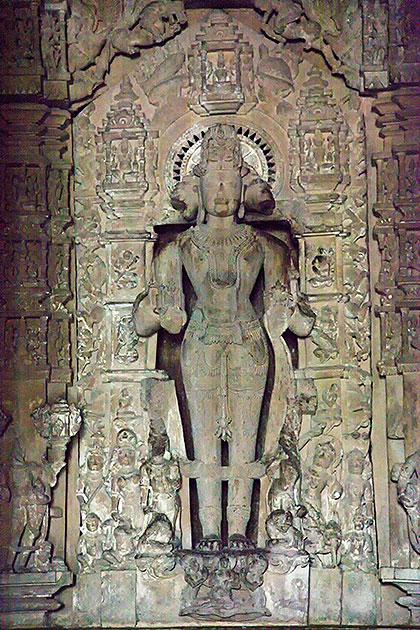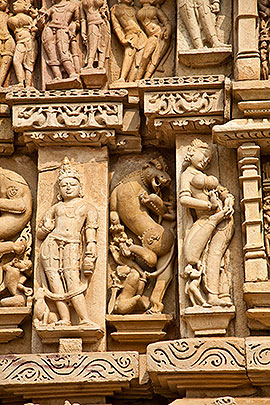Khajuraho: Varaha Shrine, Matangeshwar Temple, Lakshmana Temple, Kandariya Mahadeva Temple, Jagadambi Temple, Parvati Temple, Vishvanath Temple, Adinatha Temple, Parsvanatha Temple
During the 10th to 13th centuries Khajuraho was the peacetime capital of the Chandela Dynasty. Under the patronage of the Chandelas, and particularly Kings Yashovarman and Vidyadhara, at least 25 temples were constructed at Khajuraho, mostly between 900 AD and 1100 AD. Abandoned after the decline of the Chandelas in the 13th century, they were rediscovered beneath dense forest overgrowth by Captain TS Burt of the Bengal Engineers in 1838. Now a UNESCO World Heritage Site, the surviving temples are divided into three groups -- western, eastern and southern. We visit the western group first, and then the eastern group.

A small bazaar operates just outside the entrance.

Entering the western group grounds, we walk toward the temples.
Varaha Shrine


"Varaha sanctuary is an open pavilion with a pointed roof, enshrining the icon of Varaha, the third incarnation of Vishnu [as a boar]. The Varaha image dates to about AD 950 and was possibly installed by Chandela king Yashovarman as a celebration of victory over his Pratihara overlord. The massive Boar, measuring 2.66 m. by 1.75 m., is carved out of a single piece of solid yellow sandstone and is canopied by an exquisite lotus ceiling.
"This magnificent Khajuraho sculpture in the round is positioned in the centre of the shrine with space for devotees to circumambulate. This divine animal carries more than 675 miniature figures on its body, in twelve neatly carved rows. These figures depict all the important divinities of the Hindu pantheon, including Ganesha, the seven Mothers, the seven sages, the eight Guardians of Space, the nine planetary divinities, the river goddesses, the seas, the Rudras, and the different forms of Vishnu. There was also an image of the Earth Goddess, which is now missing. Today, only her feet can be seen attached to the pedestal". [www.indianetzone.com]


Details of the boar's head and miniature figures carved on its body.
Matangeshwar Temple

The Matangeshwar Temple is the oldest in the western group at Khajuraho, having been built around 900 AD by the Chandela rulers. It is the only one in the western group that is still in active use. Dedicated to Shiva, the God of destruction, it houses an 8-ft high lingam said to be the largest in the country. This is the most sacred temple in the entire region and devotees come from far and wide to worship here, bringing containers of water to ritually drop at the feet of the deity. This temple is very close to the Lakshmana Temple (separated by the fence visible above), and while visiting that temple we photograph the Matangeshwar Temple and its steady stream of worshipful visitors, but we do not visit it ourselves.
Lakshmana Temple

The Lakshmana Temple (930 AD) is almost as old as the Matangeshwar Temple next to it (at extreme left, above). A grand edifice standing on a high platform, it is dedicated to Lord Vishnu – the preserver of the Hindu Trinity of Gods (Brahma, Vishnu and Lakshmi). The platform (meant for the ritual pradakshina or circumambulation) has a sculptural frieze of elephants and horsemen in procession. On the platform, in front of the main temple on each side are mandapas (pavilions) -- one for Varaha (left) and one for Devi (right). The outer walls of the three sandstone structures are completely carved with bands of sculptural decoration with exquisite figures of apsaras (celestial courtesans/nymphs), the guardians of the directions and other divine creatures. Erotic panels are centered on the two balconies of the stone temple.


This subsidiary shrine stands at a corner of the platform.

Lord Ganesha, we presume.


Southwest corner (above left) and south side center (above right), with some wall details below.




Closer details of some of the carvings. Some figures are doing things they probably shouldn't.



Pillars and pillar details.



An inner wall repeats the themes seen on outer walls.

The sanctum contains a three-headed idol of Vaikuntha Vishnu's incarnations, Narasimha and Varaha (the same boar incarnation seen earlier in its own shrine). It was given to King Yasovarman by his Pratihara overlord, Devapala. The image was brought originally from Tibet (then known as Bhosa), where the cult of worshipping Vishnu in his Vaikuntha (the multi-headed Vishnu) avatar was popular.

The tower of the main temple is carved with geometric decorations.
Kandariya Mahadeva and Devi Jagadambi Temples

A short walk west from the Lakshmana Temple brings us to another pair of temples on the same platform -- the Kandariya Mahadeva Temple (left) and the Devi Jagadambi Temple (right). The Devi Jagadambi Temple is the older of the two (constructed 1000-1025 AD); it was originally dedicated to Vishnu, but now honors Parvati. It is smaller and more delicately proportioned than its more famous neighbor on the platform. The Kandariya Mahadeva Temple (a Shiva temple constructed 1025-1050 AD) is the largest (98 ft. tall) and most impressive temple at Khajuraho. It is adorned with over 800 sculptures of gods, goddesses, animals, warriors, dancers, musicians, voluptuous maidens and erotic scenes.

Kandariya Mahadeva Temple, seen from the south side, above, and from the southeast (below left). Below right, a closer look at the north side of the temple.




Four brightly-dressed women with a child are framed by the eastward-facing Ardha Mandapa (entrance porch), which has a finely-detailed makara torana (ceremonial arch), flanked by two crocodile heads.The four ladies and little girl also posed for a photograph outside the temple, below.

Parvati and Vishvanath Temples

As we begin to leave the western group, we pass the Parvati Temple (right) and the Vishvanath Temple behind it to the left. The Vishvanath Temple is a Shiva temple, similar to the Kandariya Mahadeva, but with somewhat less grandeur. The small Parvati Temple has had extensive recent restoration. It houses an image of the goddess Parvati standing on an iguana, though the sanctum door has an image of Vishnu in the center. Unfortunately we have no time to visit either of these temples, as we move on to the eastern group.
Adinatha Temple


In the eastern group we visit two Jain temples. The first of these is the relatively small 11th century Adinatha Temple, shown here, with detail views below. Many of the carvings depict court musicians.







An idol of the Jain saint Adinath sits within, with an inscription dated Sam 1215 during the rule of Chandela king Madanavarman.
Parsvanatha Temple

This is the much larger and older Parsvanatha Temple, dating from 954 AD, during the reign of Chandela king Dhanga.



Modern Jain Additions

The eastern group includes a number of contemporary additions by the Jains, including a surrounding wall, temples, shrines and a museum.